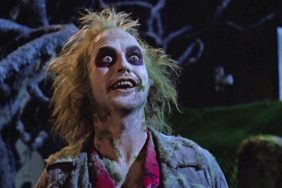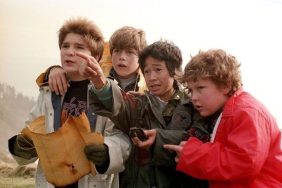
There are movies, and then there are gimmick movies. It’s not a tricky distinction: gimmick movies have a gimmick beyond simply telling a story. Sometimes the movie was made in a particularly novel way, such as presenting the entire film on the screen of a teenager’s laptop (Unfriended), and sometimes it’s a marketing ploy, like giving out barf bags because the movie is supposed to be ridiculously gross (Mark of the Devil).
Gimmick movies can be awesome, either because or in spite of the so-called gimmick, and sometimes they suck because the filmmakers relied too much on the gimmick and not enough on the characters and story. But as always, we’re staying positive on The Best Movie Ever, and we’ve asked our three film critics – William Bibbiani, Witney Seibold and Brian Formo – to wrack their brains and present their individual picks for the best gimmick movie ever made.
What they thought qualified as a “gimmick movie” might vary, but they stand by their choices. So let us know your favorite gimmick movie, and come back next week for an all new, highly debatable installment of CraveOnline’s Best Movie Ever!
Check Out: The Best Movie Ever: Sci-Fi Movies of the 21st Century
Witney Seibold’s Pick: The Tingler (1959)

One cannot write about movie gimmicks without immediately resorting to the career of William Castle. Castle, the most stalwart showman since P.T. Barnum and arguably one of America’s finest filmmakers, was a prolific genre director, making a long string of westerns all through the ’40s and ’50s. In 1958, however, he had accumulated enough clout to start producing as well, and elected to move into the lucrative horror genre. Ever the businessman, Castle had to think of something unique to set his movie apart from the scads of other horror cheapies in all the other neighborhood theaters. As such, kids going to see his film Macabre, were offered life insurance policies (sold by comely actresses posing as nurses) in the event they should die of fright during the film. From there, it was off to the races for Castle. In 1959, he filmed The House on Haunted Hill in Emergo!, which was a flying skeleton that would soar above the audience’s head during a key scene in the movie. He would go on to invent Illusion-O, the Fright Break, and the Punishment Poll.
His best film, however – and I feel his best gimmick – came in 1959 with the release of The Tingler. In The Tingler, Vincent Price plays an embittered scientist who is studying the effects of extreme fear on the human body. He has found that a strange biological entity seems to grow on one’s spine when they are afraid. He wishes to harvest this entity, but it shrivels up when one screams. The film involves trying more and more outlandish experiments to induce extreme fear, including one scene where Price injects himself with LSD (!). The gimmick of The Tingler was Percepto!. Random seats throughout choice movie theaters would be rigged with violent vibrating cushions, ensuring that choice viewers would be given the appropriate “goose” during key scenes in the movie.
I am too young to have experienced William Castle films during their initial runs, and it’s one of my life’s greatest failings. Imagine the joy, the carnival atmosphere, the palpable giddy little-boy excitement of wandering into a Castle film in the late ’50s or early ’60s. Of picking up your Illusion-O viewer, or your Punishment Poll voting card, of wondering if a living Tingler really was in that covered cage, and eagerly awaiting the start of the film. It would be a defining moment of your youth. No one was more devoted to entertainment like William Castle, and, if you’re 10, no films are more entertaining.
Check Out: The Best Movie Ever: Kurt Russell
William Bibbiani’s Pick: Psycho (1960)

“The manager of this theatre has been instructed at the risk of his life, not to admit to the theatre any persons after the picture starts. Any spurious attempts to enter by side doors, fire escapes or ventilating shafts will be met by force. The entire objective of this extraordinary policy, of course, is to help you enjoy PSYCHO more.”
~ Alfred Hitchcock
Now, THAT is a gimmick. Of course, Psycho is a gimmicky movie to start with. Shockingly violent for its time, daring in its structure (killing off your protagonist halfway through the movie is still a rarity), and that ending… that now famous, then scandalous ending… is a scream. The marketing campaign for Psycho, like most of the best marketing campaigns, told the audience that Alfred Hitchcock’s latest thriller was more than a movie, it was an event. Psycho was not to be missed.
I do declare Psycho to be “the best gimmick movie ever,” but the distinction is nebulous. Although no one would deny that the works of William Castle (above) are prototypical examples, you could declare any movie with a single, distinctive and inventive selling point to be a gimmick film. Boyhood is a gimmick film for its central conceit, filming over the course of 12 years so the cast could age realistically on camera. Lolita was a gimmick film because, as the posters declared, “How Did They Ever Make a Movie of Lolita?”
But the best gimmick movies make the most of their gimmicks, owning them completely, and using them to tell a great story. (And yes, Lolita would also be a contender, but nowadays the gimmick of simply making the film no longer truly plays.) Psycho still feels remarkable over 50 years later, busting through traditions with devilish aplomb. The last few scenes are a little clunky, but no matter: its dazzling advertising campaign made good on its promises. It was one of the great cinematic events of all time. And have you ever seen that incredible trailer?
Check Out: The Best Movie Ever: Steve Martin
Brian Formo’s Pick: Clueless (1995)

Real gimmick movies were the ones that incorporated vibrating seats, pumped in smells into theater, or planted audience members as screaming participants. But these are all gimmicks that I’ve only read about, and never actually experienced (although I’ve seen The Tingler without the tingling seats and liked it as is). In attempt at going-with-what-I-know, I was a teenager in the 90s, and I was constantly marketed to via another gimmick: updating classic literature or plays and setting them in modern day American high school.
The best film to come from this cycle was the first: Clueless. And it’s the best because it didn’t have the built-in intention of being Cliff Notes with a bitchin’ soundtrack, nor does it feel like playtime (teens acting as tragic adults). In fact, Jane Austen’s Emma doesn’t even get a based-on credit (although it is only loosely based on Emma; it’s certainly Amy Heckerling who created the immensely quotable dialogue and Beverly Hills lingo). Clueless made so much money and become so popular with teens that Hollywood wanted to catch lightning in a bottle over and over, and they mostly just focused on the classical novel skeleton approach (which is an easier formula to focus on than creating characters who are foolish but also strive for a sense of sensibility).
Side by side, Cher Horowitz (Alicia Silverstone) and her friends bear more than a passing resemblance to Emma Woodhouse and the rest of Austenland. Cher does do “silly things” that “cease to be silly” once she becomes “sensible.” Cher’s attempts to navigate the new girl, Tai (Brittany Murphy), through the limited prom (marriage) prospects at their school is due to the uniformity of the village (high school). In the sharpest move of Heckerling’s adaptation, the difference in social class at an affluent school is defined less by parental money, but by a division between classical standards of classiness (clothes, speech) and non-classical recreational lifestyles (mallrats, skateboarders, and those who listen to Radiohead represent the undesirable association of “new money”).








